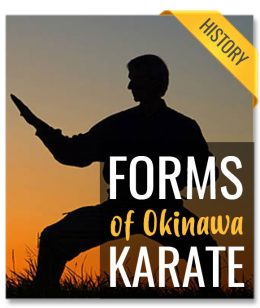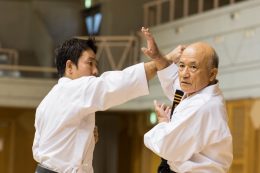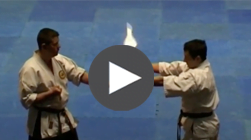Another empi technique from Kushanku (Kanku) kata. Similar to basic Naihanchi application but here you add kick to shock your opponent. Also keep in mind that we use elbow strike also as escape from grab.
All posts tagged karate kata
Kushanku tsuki bunkai as escape from diagonal hand grabbing
One more Kushanku bunkai. This is how we do it. :) Use tsuki for escape from diagonal grab. Dont use harai uke and your forearm, but rather execute tsuki and snap opponents elbow with your upper arm and shoulder. This is form of kage tsuki and bunkai is similar as in Naihanchi kata. This move is same against grabbing your sleeve, shoulder and double arm grab to your neck or lapel. And most important – use hikite.
Warm up exercise – ground work
Here are two good warm up exercises and nice way to cover some ground fighting if you ever end up in this position. First one is about front mount attacker and how to escape from being under. Second exercise is about how to cover from kicking, stomping and punching when you are on the ground.
How to practice Shuto in dojo without makiwara
This is how we practice shuto uchi in our dojo. We use woodboards as fokus pads. :) Usually folks practice shuto on boxing bag, but bag is too soft for shuto. Shuto is meant to break a bones and bones are not soft. We are using left overs from temashiwari for practice but any wood is good. Please dont practice on your doors because you will destroy it. :) If you try this go slow and dont push it – it is easy to get hurt.
Kushanku kata – Tora Guchi “Tiger’s jaw” bunkai
This movement can be seen in many martial arts movies because it looks mysterious, but dont be fooled it is very effective. You can find this technique in many karate katas and it is mentioned in Bubishi. Name Tora Guchi means “Tigers Jaws”. This is defence against hair grab or throat grab by grabbing simultaneously his throat and testicles and there is another variation of poking attacker eyes and grabbing testicles.
Naihanchi kata empi uchi bunkai application
Naihanchi (Tekki) kata bunkai. This is about first sequence haito – empi uchi. Main point here is to use elbow to escape from grab and counter at the same time. Keep in mind that execute empi uchi in way that it is also escaping technique.
Oss. :)
Shorin Passai kata – mikazuki-empi bunkai
This is bunkai from kata Passai, also known as Basai Dai in Shotokan. It is close distance techniques sequence. You should execute
- Mikazuki kick,
Elbow strike,
Uraken to attackers face,
Escape from grab and
grab attacker groin as ultimate measure.
It is pretty cruel sequence, but it is sometimes necessary to be very lethal if you are not as strong or big as your opponent. Version of kata that we practice is known as Oyadomari Passai or Tomari Passai and it is the oldest version of this kata as far as I know.
Oss. :)
Passai kata bunkai – Sagurite udewa
Sagurite – searching hand. This technique is from kata Passai and it is aimed at attackers eyes. Parry with rear hand and poke with front hand because front hand can cover more distance. Use neko ashi dachi to align your body and cover. Eye-poke here is used as shock technique and after that you proceed with Udewa, grab head manipulate opponents neck and takedown. Funakoshi used term “Udewa” for this throw and I like that name. In Shotokan Basai Dai sagurite is replaced with generic shuto uke and bunkai is lost.
Oyadomari Passai – Shorin ryu kata video
This is Oyadomari Passai kata. That is Tomari version of Passai kata and it is generaly oldest version that survived today. This kata is modified in Shotokan and is also known as Bassai dai. Version that we practice is similar to one that is passed down through Matsubayashi school. There is saying that Passai means “Lion dance” and I think that it is highly possible because there are many paw and claw techniques that are similar to cat movements. Our dojo has lion as an amblem and Passai is our signature kata.
Kata – Forms of Traditional Karate
Katas are fighting choreographies carried on from father to son for generation. Read more…
The Kata of Shorin-ryu Seibukan
In the following article, I will briefly describe the kata of Shorin-ryu Seibukan, and their origin. Describing kata by text is very difficult. Read more…



